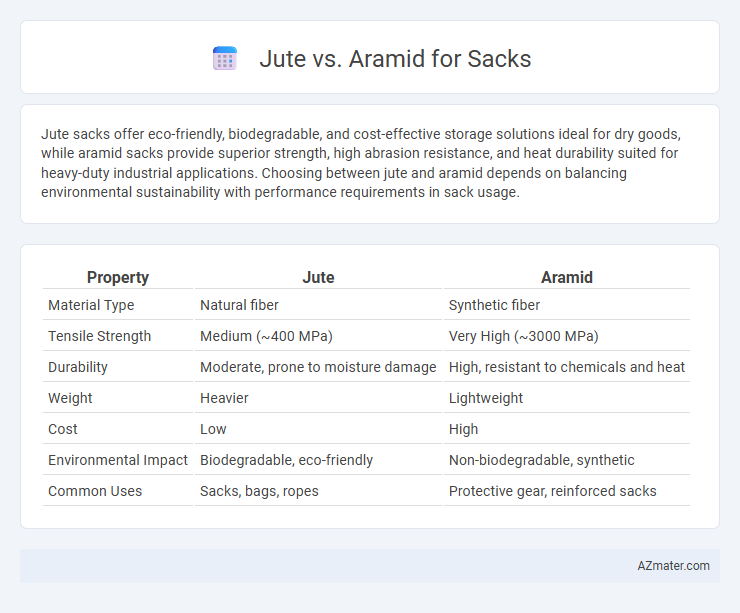Jute sacks offer eco-friendly, biodegradable, and cost-effective storage solutions ideal for dry goods, while aramid sacks provide superior strength, high abrasion resistance, and heat durability suited for heavy-duty industrial applications. Choosing between jute and aramid depends on balancing environmental sustainability with performance requirements in sack usage.
Table of Comparison
| Property | Jute | Aramid |
|---|---|---|
| Material Type | Natural fiber | Synthetic fiber |
| Tensile Strength | Medium (~400 MPa) | Very High (~3000 MPa) |
| Durability | Moderate, prone to moisture damage | High, resistant to chemicals and heat |
| Weight | Heavier | Lightweight |
| Cost | Low | High |
| Environmental Impact | Biodegradable, eco-friendly | Non-biodegradable, synthetic |
| Common Uses | Sacks, bags, ropes | Protective gear, reinforced sacks |
Introduction: Comparing Jute and Aramid for Sacks
Jute and aramid represent two distinct materials used in sack manufacturing, each with unique properties impacting performance and durability. Jute, a natural fiber known for its biodegradability and breathability, offers eco-friendly advantages ideal for agricultural and storage applications. Aramid fibers, synthetic and renowned for exceptional strength and heat resistance, are favored in industrial settings requiring enhanced protection and longevity.
Material Composition: Jute vs Aramid Fibers
Jute fibers are natural, biodegradable, and derived from the Corchorus plant, providing eco-friendly and breathable material ideal for traditional sacks. Aramid fibers, such as Kevlar, are synthetic, composed of long-chain aromatic polyamides offering exceptional strength, heat resistance, and durability for high-performance, heavy-duty sacks. The choice between jute and aramid fibers depends on sustainability priorities versus the need for enhanced mechanical properties and longevity in sack applications.
Environmental Impact: Sustainability and Biodegradability
Jute sacks offer superior environmental benefits due to their sustainability and biodegradability, as jute is a natural fiber that decomposes quickly without leaving harmful residues. Aramid sacks, made from synthetic fibers like Kevlar, present challenges in sustainability because their production relies on petrochemicals and they persist in the environment for decades. Choosing jute sacks significantly reduces carbon footprint and waste accumulation, aligning with eco-friendly and circular economy principles.
Strength and Durability: Performance Analysis
Aramid fibers exhibit significantly higher tensile strength and superior durability compared to traditional jute, making them ideal for heavy-duty sack applications requiring enhanced load-bearing capacity. Jute sacks offer moderate strength but degrade faster under moisture and abrasion, whereas aramid sacks resist wear, chemicals, and extreme temperatures, ensuring longer service life. In performance analysis, aramid outperforms jute by delivering exceptional resilience and maintaining integrity in demanding industrial environments.
Weight Considerations: Lightweight vs Heavy Duty
Aramid sacks offer lightweight solutions with exceptional tensile strength, making them ideal for heavy-duty applications requiring durable yet manageable weight materials. Jute sacks, while naturally biodegradable, tend to be heavier and better suited for moderate load carrying with traditional weight requirements. Weight considerations for sacks should balance between the lightweight advantage of aramid fibers and the eco-friendly, heavier nature of jute for specific industrial uses.
Cost Efficiency: Price Comparison for Sacks
Jute sacks generally offer superior cost efficiency compared to aramid sacks due to their lower raw material and production costs, making them a more budget-friendly option for bulk packaging. Aramid sacks, while significantly more expensive, provide enhanced durability and resistance to abrasion and chemicals, justifying the higher price in specialized industrial applications. Evaluating the price difference, jute sacks typically cost 30-50% less, making them preferable for standard sack uses where cost reduction is a primary concern.
Moisture Resistance and Weatherability
Aramid sacks demonstrate superior moisture resistance compared to jute, as aramid fibers are inherently hydrophobic and do not absorb water, preventing mold and degradation. Jute sacks, composed of natural cellulose fibers, are prone to moisture absorption, leading to weakened fiber strength and susceptibility to rot under prolonged damp conditions. Weatherability of aramid sacks is significantly higher due to their synthetic polymer composition, offering excellent UV and chemical resistance, whereas jute sacks degrade faster when exposed to sunlight and harsh environmental elements.
Usability and Applications in Various Industries
Jute offers exceptional biodegradability and breathability, making it ideal for agricultural sacks and eco-friendly packaging in industries like food storage and textiles. Aramid fibers provide superior strength, heat resistance, and durability, suited for high-performance sacks used in chemical, military, and industrial applications requiring abrasion and impact resistance. The choice between jute and aramid sacks depends heavily on environmental conditions, load requirements, and industry-specific safety standards.
Safety and Health Implications
Jute sacks offer natural biodegradability and low toxicity, minimizing environmental and health risks during production and disposal, but they lack the chemical resistance required in hazardous material handling. Aramid sacks provide superior strength and resistance to heat, chemicals, and abrasion, enhancing safety for workers exposed to harsh conditions, though their synthetic fibers may pose respiratory risks if fibers become airborne during manufacturing or cutting. Proper handling protocols and personal protective equipment are crucial when working with aramid sacks to mitigate potential respiratory hazards while benefiting from their protective properties.
Conclusion: Choosing the Right Material for Sacks
Jute sacks offer biodegradability, affordability, and breathability, making them ideal for agricultural and eco-friendly packaging. Aramid sacks provide superior strength, heat resistance, and durability, suited for heavy-duty industrial applications requiring high performance. Selecting the right material depends on balancing environmental impact with the required mechanical properties for specific sack uses.

Infographic: Jute vs Aramid for Sack
 azmater.com
azmater.com